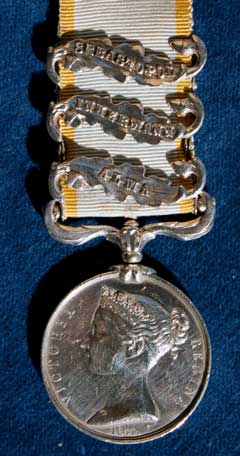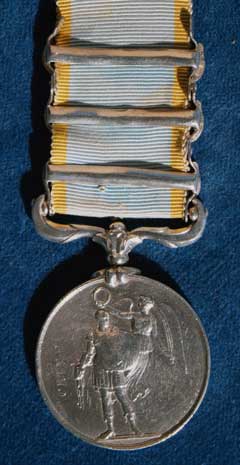MEDAL INFORMATION
Crimea Medal (28 March 1854 - 30
March 1856)
Face
The diademed head of
Queen Victoria and the legend ‘VICTORIA REGINA’. Beneath the head is the
date ‘1854’.
Reverse
A Roman warrior, with
a circular shield held in his left hand in front of him and a sword in his
right hand, being crowned with a laurel wreath by a flying figure of
Victory. The word ‘Crimea’ is inscribed vertically on his right.
Size
Approx. 36 mm
diameter. Medal and bars are of silver.
Ribbon
Approx. 28 mm wide.
Duck egg blue with yellow edges - each approx. 3mm wide.
Suspension
The ribbon passes
through a foliated ornamental swivel suspender, the pattern of which is
peculiar to this medal.
Naming
Originally issued
un-named, but many were returned for official naming, on the edge, in
either square indented or engraved capitals.
Bars
Five bars were issued
to British servicemen: “ALMA” (20 September 1854); “BALACLAVA” (25 October
1854); “INKERMAN” (5 November 1854); “SEBASTOPOL” (11 September 1854 to 9
September 1855) and “AZOFF” (25 May to 9 September 1855). The latter bar
was only issued to Naval and Marine personnel who served in the Sea of
Azoff. The maximum number of bars awarded to any one individual was
four. The oak leaf and acorn pattern of the bar is unique to this medal.
The correct order of wearing the bars is in date order from the bottom
upwards.
Awarded
For service in the
Crimean peninsula during the war of 1854 to 1856 between Russian and
France, Great Britain and Sardinia. The latter three states wanted to
prevent Russia from gaining control of the Bosphorus after the Czar had
ordered the invasion of the Turkish provinces of Moldavia and Wallachia.
Following the end of the war the Treaty of Paris guaranteed the integrity
of the Turkish Empire and Moldavia and Wallachia became self-governing.
They eventually formed part of the new Kingdom of Romania. The war showed
that, although the fighting qualities of its regimental officers and men
were second to none, the British Army was seriously lacking in its supply
organisations and in the quality of its General officers.
The award of the medal to
those who served in the Crimea, and of the bars “ALMA” and “INKERMAN” to
those who participated in those battles, was authorised on 15 December
1854 after the Queen had been so impressed with the deeds of her Army.
This was the first war her army had fought against a modern European power
since Waterloo in 1815. It is for this reason that the medal bears the
date ‘1854’. The awards of the bars for the battle of Balaclava and the
siege of Sebastopol, to those present at those actions, were authorised in
February and October 1855 respectively.
Around 275,000 of these
medals were issued by the British Government - many without bars to those
who served in the Crimea, but who took no part in the actions for which
bars were awarded.
The King’s Own
The Regiment was
stationed at Edinburgh in early 1854 and due to the growing tension
between Russian and Turkey was placed in readiness for overseas service.
On 8th March it embarked at Leith and after a brief halt at Malta and
longer stays at Gallipoli and Varna (Turkey), it landed in the Crimea near
Eupatoria on 14th September as part of the 3rd Division. It was present
at the Battle of the Alma and qualified for the clasp “INKERMAN” on
account of its heavy engagement with the enemy in the new trenches in
front of Sebastopol on that day. It remained encamped before Sebastopol
throughout the siege, the appalling conditions under which the troops
lived and fought, and the lack of clothing, provisions and medical care
caused far more casualties than did the enemy. Private Thomas Grady was
awarded the Regiment’s first Victoria Cross and was also one of the
Regiment’s sixteen recipients of the Distinguished Conduct Medal. Some
1417 Crimea Medals, many with three clasps, were awarded to officers and
men of the King’s Own. The Regiment was awarded the Battle Honours
“ALMA”, “INKERMAN” and “SEBASTOPOL” to be borne on its colours.
Crimea Medals in the museum's collection


The Crimea Medal



